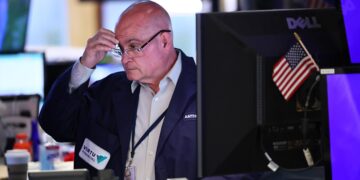If we had to pick a theme for our midyear outlook this year, it would be “wait and see.” Wall Street’s crystal ball has rarely been murkier.
Will the Trump administration’s tariffs reignite inflation? Will the U.S. economy slide into a recession? Has the U.S. stock market put a spring swoon definitively behind it? The answer to all of the above: We’ll have to wait and see.
That’s always the answer when it comes to forecasting, of course, especially the direction of the market. But the weight of the evidence usually tips the scales one way or another, toward offense or defense — only now, the evidence is still up in the air and shifting almost daily.
Sign up for Kiplinger’s Free E-Newsletters
Profit and prosper with the best of expert advice on investing, taxes, retirement, personal finance and more – straight to your e-mail.
Profit and prosper with the best of expert advice – straight to your e-mail.
“These are interesting times,” says Jody Jonsson, a portfolio manager and vice chair of fund company Capital Group with 38 years of financial industry experience. “What’s happening right now is different than anything I’ve seen in my entire career, a fundamental restructuring of the world order — politically, economically and militarily.”
We don’t know how all of 2025’s known unknowns will resolve. But it’s certain that uncertainty will reign for a while longer.
There are signs that the broad U.S. stock market may have already hit its low, and it closed out the month of April on a hot streak. Yet plenty of skepticism remains about a durable bullish breakout. The market is likely to stay choppy for much of the rest of the year, whipsawed by policy news from the White House and by economic data that will either confirm or contradict the recent abysmal readings on investor sentiment and confidence.
“Everyone craves certainty,” says Keith Lerner, chief market strategist at Truist Wealth. “But in this world, you have to think about what could go right and what could go wrong, and what belongs in your portfolio depending on different outcomes.”
Even if all goes fairly well — that is, if tariffs as proposed now come down as deals are negotiated and the Trump administration turns to traditionally pro-growth tax cuts and deregulatory policies — investors could still wind up at year-end not far from where they finished in 2024.
Dashed hopes
In our January outlook issue, we said an S&P 500 index level between 6300 and 6600 made sense for year-end. At the time, strategists were raising their price targets faster than we could keep up with them, and the mood on Wall Street was euphoric.
But after a tariff-induced tantrum turned a run-of-the-mill market correction into a near-bear experience in April, with the S&P 500 down nearly 19% from its high (20% marks a bear market), Wall Street’s forecasters brought out their markdown pens.
The range of year-end S&P 500 targets is wide — between 5550 and 6600 among analysts we talked to or track. We think somewhere in the middle is a safer bet — say, a level between 5800 and 6000. At the midpoint, that would imply a nearly 6% rise in price from the April 30 close of 5569. (Prices, returns and other data in this story are as of April 30, unless otherwise noted.)
That would still be down some 4% from the market’s February high, and essentially flat compared with 2024’s close. Dividends, with an average annualized yield of 1.4% for stocks in the S&P 500 recently, will make a more important contribution to total returns.
Peak uncertainty
Whatever their political persuasion, investors re-learned the lesson this year that markets hate uncertainty.
President Trump’s first 100 days in office, which ended on April 30, delivered that in spades, leading to the second-worst performance for a presidential debut since 1945, behind only Richard Nixon’s second term. Amid a barrage of executive orders and federal workforce firings, on-again, off-again tariffs most roiled financial markets. Is the worst over? Many on Wall Street think so.
“There’s a chance that peak-level uncertainty occurred on April 2,” when reciprocal tariffs were first rolled out, says Chris Fasciano, chief market strategist at Commonwealth Financial Network.
The ferocity of the downturn that followed, extreme bearish sentiment among investors and swift downward revisions of corporate earnings estimates can all be contrarian indicators that signal a market trough.
“People are excessively negative,” says Brian Belski, chief investment strategist at BMO Capital Markets. “They’re acting like it’s the end of the world.”
Belski, who recently lowered his year-end S&P 500 price target from 6700 to a still healthy 6100, calls himself “bullish but with a dose of reality.”
Indeed, by the end of April, a relief rally had pushed stocks up 12% from their low earlier in the volatile month, and in the first days of May, the longest daily winning streak in more than 20 years put the S&P 500 back above pre-tariff levels.
Still, many on Wall Street warn that we could see months of a range-bound market ahead, in which the S&P 500 retests its lows and, unless there’s a catalyst like a solid trade deal with China, struggles to break through to new highs.
“When you look at drawdowns of 15% or more, you don’t necessarily see the kind of V-shaped recovery that we saw in 2020,” says George Smith, portfolio strategist at LPL Financial. “More often than not, markets bumble around in a bottoming process for a few months, depending on whether there’s a recession that materializes.”
That argues for being patient about picking your opportunities. “We’re in the wait-and-see camp,” says Smith. Says Darrell Cronk, president of Wells Fargo Investment Institute: “We would be careful here chasing too hard on equities, as you will likely get a better opportunity in the coming weeks.”
Doug Ramsey, chief investment officer of money management firm Leuthold Group, is one of Wall Street’s stalwart bears.
“I still wouldn’t rule out a decline of 35% from peak to trough on the S&P 500,” he says. That would take the benchmark down to roughly the 4000 level. “It sounds like a lot,” Ramsey concedes.
His dour views stem from a dim outlook for the economy. But he also thinks that given how overvalued the stock market was at the start of the correction, it did not decline enough to make valuations compelling enough for a durable rally.
The S&P 500, trading at more than 22 times estimated earnings at its peak, fell to about 19 times earnings at its low. “Modern-era lows have been in the 14 to 15 times range,” Ramsey notes.
By the end of April, the benchmark was back to trading at 20 times earnings.
Eyes on the economy
So-called “soft” data on investor sentiment and consumer confidence has been plunging for months — which matters, because consumer spending accounts for roughly two-thirds of the U.S. economy.
The Conference Board reported that consumer confidence fell for the fifth straight month in April. The expectations component of the survey, based on consumers’ short-term outlook for income, business and labor market conditions, dropped to its lowest level since October 2011 and has fallen well below the threshold that usually signals a recession is ahead.
The decline in confidence was broad-based among all age groups, most income groups and all political affiliations, the Conference Board said.
There has been little “hard” data so far, in terms of reports on economic activity, to justify — or belie — consumers’ pessimism.
News that gross domestic product contracted in the first quarter was unsettling, although not as bad as it appeared at first, after economists dug into the details on consumer and business spending. (Two successive quarters of contraction is the traditional indicator of a recession.)
“We expect GDP growth to slow sharply this year as higher tariffs and a spike in policy uncertainty weigh on disposable income, consumer spending and business investment, and see a 45% probability of entering a recession over the next 12 months,” wrote Goldman Sachs economists in a recent note to clients.
An April jobs report, however, showed a still-resilient labor market, with the number of jobs added above expectations, albeit below the prior month’s levels, and unemployment steady at 4.2%.
“It seems that businesses are mostly staying the course for now in the face of considerable tariff uncertainty,” says Jason Pride, chief of investment strategy and research at Glenmede, a money management firm.
But economists at BofA Securities warn that immigration restrictions are likely to weigh on payrolls in the coming months, especially in sectors such as leisure and hospitality, education and health, and construction.
Tariffs should begin to weigh on the trade, transportation and warehousing sectors. Kiplinger expects an unemployment rate of 4.5% by year-end.
A consensus of economists surveyed in April by Blue Chip Economic Indicators estimates a 63% probability of stagflation-like conditions emerging in the economy over the next 12 months — a scenario in which economic growth stagnates amid rising inflation.
The economists on average expect U.S. GDP growth of 1.4% for 2025, down from their estimate of 2.0% in March, and down from a growth rate of 2.8% in 2024. They see inflation, as measured by the consumer price index, averaging 3.3% in 2025, up from 2.9% in 2024.
The path ahead will require finesse on the part of the Federal Reserve, as the central bank fights inflation with higher rates but slower economic growth with lower ones.
“The Fed is trying to gauge in real time whether the ‘stag’ or the ‘flation’ is the bigger risk to the outlook,” says Glenmede’s Pride.
Traders were recently betting on three quarter-point rate cuts this year, starting at the Fed’s July meeting, according to the tracker CME FedWatch. That would bring the Fed’s benchmark rate to a range of 3.50% to 3.75% at year-end. Kiplinger expects that yields on 10-year Treasury notes, which spiked to nearly 5% in mid April during their own tariff tantrum, could slip to 4% as the economy slows.
We should note here that the stock market anticipates the economy rather than reacts to it. In other words, by the time we know we’re in a recession, stocks have typically turned the corner already and are off to the races.
The lesson: Stick to your investment plan and avoid trying to time the market.
A check-engine light
Corporate earnings growth is the stock market’s engine. Is it sputtering? The earnings picture is among the cloudiest for the second half of 2025.
As first-quarter earnings season got under way, executives at S&P 500 companies brought up the word tariffs in 93% of calls with analysts and investors through late April, according to Morgan Stanley research, up from 53% in the fourth quarter of 2024; uncertainty was discussed in 89% of calls, compared with 38% for the fourth quarter.
Some companies have declined to give the usual guidance about future results or have taken the unusual step of outlining potential outcomes under different scenarios.
For example, Skechers, the footwear company, said it was rescinding prior guidance and not providing an update “due to macroeconomic uncertainty stemming from global trade policies.”
United Airlines said its outlook “is dependent on the macro environment, which the company believes is impossible to predict this year with any degree of confidence.” United estimated 2025 earnings under a “stable environment” at $11.50 to $13.50 a share; under a “recessionary environment” at $9.00 to $11.00 a share.
According to FactSet Research Systems, 58% of companies reporting so far have given negative guidance for the current fiscal year.
Closely watched reports from investors’ favorite tech stocks helped buoy the market’s late-April rally, but there were still a few red flags: Apple, for one, indicated that the tariff situation, if it remains unchanged, could add $900 million to costs in the quarter that ends in June.
Overall, analysts are estimating annual earnings growth of nearly 9% for S&P 500 companies in 2025, according to earnings tracker LSEG I/B/E/S. In January, analysts had estimated earnings growth of 14%. Even so, the current consensus is still too bullish, according to a number of strategists.
Goldman Sachs analysts are forecasting 3% earnings growth this year; UBS Global Wealth Management strategists are looking for profits to be flat.
Where to invest
If they haven’t already, says Capital Group equity investment director David Polak, the first thing investors should do is “make sure they have a steady ship; identify where they might have risk. If you have companies exposed to tariff outcomes, you might want to do something about that. Once you steady the ship, then look at companies that are presenting an opportunity.”
No stock is tariff-proof, because the impact of tariffs is economy-wide, says Polak. But the degree of sensitivity matters, and service providers, including insurance companies, should fare better than manufacturers.
A favorite of Capital Group’s Jonsson is Chubb (CB, $286). “It’s diversified globally, trades at a low price-earnings multiple and goes up when markets go up, but does better in down periods,” she says.
While uncertainty persists, it makes sense to tilt toward defensive stocks in your portfolio, especially if capital preservation is your main goal.
That includes sectors such as consumer staples and utilities, which outperformed the S&P 500 by about 11 percentage points in the correction and are still ahead of the market for the year to date. Add a dividend cushion with Schwab U.S. Dividend Equity (SCHD, $26), a member of the Kiplinger ETF 20, the list of our favorite exchange-traded funds.
Quality is also key. Shunned by investors for a decade, firms whose stocks trade at bargain prices relative to earnings and other metrics have spent the time repairing their balance sheets and now account for a high proportion of quality names, according to analysts at BofA Securities. Value stalwart Dodge & Cox Stock (DODGX) is one of the Kiplinger 25, the list of our favorite actively managed no-load funds. Or look at ETF 20 pick JPMorgan U.S. Quality Factor (JQUA, $56).
If you’ve got no stomach for market gyrations, focus on low-volatility stocks with an ETF such as iShares MSCI USA Minimum Volatility (USMV, $93).
From the start of the year through April 30, the fund is up 4.5%, including dividends — almost the mirror image of the S&P 500’s negative 4.9% return. Conversely, you could make a virtue of market volatility with CME Group (CME, $277), which operates markets for futures and options trading. “Whether markets are going up or down, they’ve got a contract on everything that trades,” says Jonsson. The stock yields a generous 3.9%.
Just don’t go overboard on defense. The best portfolio to ride out 2025 is one that balances safety with growth. The snap-back rally in April shows that “growthier,” tech-oriented and economy-sensitive U.S. names are worth consideration.
“The artificial intelligence and productivity growth story is still here,” says LPL’s Smith, who says he remains positive on U.S. large-company growth stocks. CFRA strategists also recommend tilting toward stocks in the technology and communications-services sectors. Stocks they rate “buy” include cybersecurity firm CrowdStrike (CRWD, $429) and T-Mobile US (TMUS, $247).
Several strategists are bullish on financials. “They’re amazing,” says BMO’s Belski, who sees a cash-rich sector with attractive dividends that could benefit from potential banking deregulation. Find a wide array of insurers, banks and payment processors in an ETF like Financial Select Sector SPDR (XLF, $49).
International stock markets have languished for years relative to the U.S., despite cheaper valuations. But they are having a moment in 2025. The MSCI EAFE index is up nearly 12% so far this year; the MSCI Europe index has soared more than 15%.
“We’ve been Team USA for the past several years — Captain America with a capital C and a capital A,” says Truist’s Lerner.
He still favors U.S. stocks, but over the past six months he has boosted international exposure. A weaker dollar benefits U.S. investors who invest overseas, as foreign gains translate into more greenbacks back home.
And Commonwealth’s Fasciano says increased spending — in Europe on infrastructure and defense and in China on stimulating consumer demand — could be the catalyst that international markets have been lacking.
Small- and mid-cap stocks should be on your radar. Although small-company stocks, especially, have been among the worst performers so far this year, that may change if in fact we do get a recession.
Those stocks, particularly sensitive to economic swings and interest rates, will be first out of the gate in the recovery. DF Dent Midcap Growth (DFDMX) and T. Rowe Price Small-Cap Value (PRSVX) are Kip 25 funds.
Fixed-income investors should not be spooked by volatility in the bond market in April, when long-term bond yields spiked as some investors worried that the safe-haven status of U.S. Treasuries was jeopardized.
“We’re trying to separate the signal from the noise” says Chitrang Purani, a fixed-income portfolio manager for Capital Group.
Although volatility could persist, Purani believes bonds will fulfill their role as portfolio ballast over the medium and long term.
For now, Purani recommends that investors look for high-quality yields with resilience in the event of market declines, including short- and intermediate-term Treasuries.
“Focus on that part of the curve — it should benefit if economic growth slows down. And if it doesn’t, there are still attractive yields to be harvested,” he says.
Purani also likes higher-quality corporate bonds, securitized credit (bonds backed by pools of IOUs) and Treasury inflation-protected securities.
Funds we like include Kip ETF 20 member iShares Short Duration Bond Active (NEAR, $51), yielding 4.5% and holding a mix of government, corporate and securitized debt, and Baird Aggregate Bond (BAGSX), a Kip 25 fund with a 4% yield and a 3% year-to-date return.
This is a good time to explore some outside-the-box diversifiers for small slivers of your portfolio.
Gold, trading at roughly $3,300 per ounce recently, is just about the best-performing asset for the year to date, as investors tend to flock to the yellow metal in times of geopolitical and economic uncertainty. Given its parabolic rise, wait for gold to digest recent gains, or for a pullback closer to $3,000 an ounce, advises Truist’s Lerner. iShares Gold Trust (IAU, $62) is an easy way to buy. Or consider miners such as Newmont (NEM, $53), rated “buy” by analysts at Argus Research, who just raised their 12-month price target for the stock to $63 a share.
A final thought as we head into the rest of 2025. Aside from its gut-wrenching volatility, the year may well be remembered as the time when a diversified portfolio took on a market dominated by the Magnificent Seven — and won.
“After being out of favor for several years, diversification is back in vogue,” says Fasciano. “It’s the best way to navigate uncertainty, and the opportunities are broader than they have been.”
Note: This item first appeared in Kiplinger Personal Finance Magazine, a monthly, trustworthy source of advice and guidance. Subscribe to help you make more money and keep more of the money you make here.



















